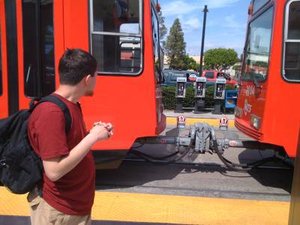Recently I discovered that my 23-year-old autistic son, Jeremy, has synesthesia. He sees numbers and letters in colors. He also sees people's names based on the color of their personality. Green represents calm, red represents anxiety. Last week I was his support person for a full day and I was multitasking to get work done while assisting him. I was sure he could feel my hyperness. Jokingly, I asked him what color my name was that day and he spelled out, "mostly green with a little red around the edge."
That about sums up how I feel most of the time when trying to get work done and making sure Jeremy has the supports he needs. And that is how I feel about autism as well: Most of the time I am positive in my approach and the information I share with educators and parents is meant to be optimistic and inspiring as well as practical. With information people feel empowered.

But there are some topics that are really hard to discuss, and those are the safety issues such as sexual abuse, the risk of wandering, and the fact that many students continue to be subjected to the use of restraints and seclusion as part of their education and behavior intervention plans in some cases. These are topics most of us usually don't think about -- or want to think about -- until something happens to someone you love. We already have enough on our plates trying to figure out the best treatment plans and educational provisions that our children or students need (whether they are young children or young adults). We may also subconsciously think if we ignore the possibility, that these bad things won't happen to us, and that the risk of a safety crisis will go away.
However, no matter the age or ability level, no person on the spectrum is safe from danger. People will argue that neither are the neurotypicals, but most individuals with an autism spectrum disorder (ASD) do not have that "antenna" most others have that helps keep people safe. Anyone with a loved one on the spectrum will understand how problematic the area of safety is for the autism community.
Some statistics:
• Roughly half, or 48 percent, of children with an ASD attempt to elope from a safe environment, a rate nearly four times higher than their unaffected siblings (National Autism Association, Lethal Outcomes in ASD Wandering, 2012).
• Children with ASD are eight times more likely to elope between the ages of 7 and 10 than their typically-developing siblings (IAN Research Report: Elopement and Wandering, 2011).
• Half of families with elopers report they had never received advice or guidance about elopement from a professional (IAN Research Report: Elopement and Wandering, 2011).
• A study done in Nebraska of 55,000 children showed a child with any type of intellectual disability was four times more likely to be sexually abused than a child without disabilities (Sullivan & Knutson, 2000). While no specific numbers exist for individuals with autism, research suggests that this population is extremely vulnerable.
• A 2003 report of Protection and Advocacy, the State Council on Developmental Disabilities, USC University Affiliated Program, and The Tarjan Center for Developmental Disabilities, UCLA declared the neglect and abuse of people with developmental disabilities to be a public health problem for the state of California.
• In terms of bullying, in 2009, 65 percent of parents reported that their children with Asperger's syndrome had been victimized by peers in some way within the past year (Issues in Comprehensive Pediatric Nursing, 2009).
• A 2009 Government Accountability Office (GAO) investigation reported that thousands of students have been been subjected to restraints and seclusion, which can lead to physical and emotional injury and in some cases even death.
• Currently there is no federal law that prohibits the use of facedown restraints, aversive interventions that compromise health and safety, restraints that restrict breathing, and locked seclusion in public and private schools.
I'm not sharing these numbers to upset or scare the any readers -- I want people to know it is possible to be pro-active in this area and get educated on how to reduce risks. For this reason, AutismCollege.com and the National Autism Association are offering a free series of seminars on Autism Safety & Crisis Prevention, sponsored in part by The Social Express, between Feb. 11 and Feb. 18. For more information, go here.
My Autism Forecast for today? I'm hoping for mostly green, with no red in sight.
Disclosure: The author is the founder and owner of Autism College.
For more by Chantal Sicile-Kira, click here.
For more on autism, click here.